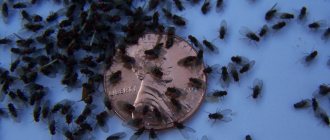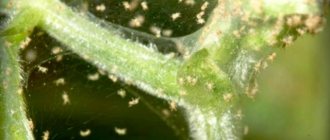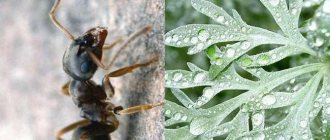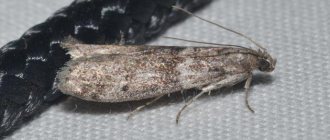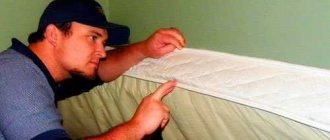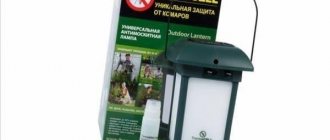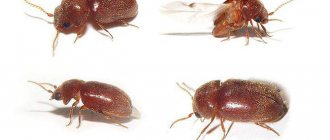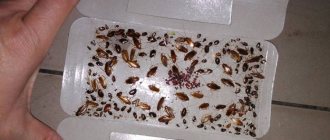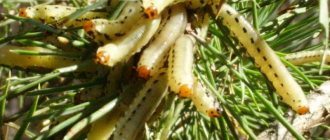If small bugs appear in household cereal supplies, this is a signal to check the entire food pantry. There are quite a lot of ways and methods of fighting insects using store-bought or folk remedies. Getting rid of weevils in an apartment in the kitchen, with proper study of the information, will not be difficult. The main thing is not to stop at just checking one container of cereal or flour, but to inspect the entire stock for the presence of insects.
Who will you have to fight with: photos and descriptions of weevils
Weevils are dangerous pests of vegetables and grains. The ancient Egyptians fought with them several thousand years ago. These beetles of the order Coleoptera number about 50,000 species. Adult insects reach 2-4 mm, have a dark brown color and a characteristic elongated front part of the head. The bugs have poorly developed wings that they cannot use.
The lifespan of insects ranges from 7 months to 2 years. A female insect can lay 2-3 clutches per year, each time 200-300 eggs per grain. Weevils settle in the apartment, mainly of the following types:
- barn - the most insatiable of its kind. Likes to settle in the kitchen and eat the cereal and flour supplies;
- rice - can be found in buckwheat or rice cereals, does not disdain bakery products;
- nut - chooses places to store nuts for his home;
- oak tree - loves acorns, but if you settle in houses, it does not refuse the food supplies that are available;
- beet - can live in gardens, vegetable gardens, using vegetables and fruits for food.
On a note!
The female weevil lays only one egg in each grain or grain. This provides the larva with sufficient food until adulthood.
What do weevils look like?
Barn weevil Weevils
(another name for them is elephant weevils) belong to the family of beetles. The pests are very small, their length is 2-5 mm. Often rice and barn varieties appear in the house. The second most common. Young weevils have a light brown tint, while adults have a black color. The beetle has a cylindrical body and an oblong head with a tube. The barn elephant has poorly developed wings, so it is not adapted to fly. This disadvantage is compensated by well-developed legs, allowing the bug to move long distances. The head has a strong oral apparatus, so it easily gnaws through grains and other hard cereals.
Where do weevils come from in apartments and why should they be removed?
The weevil gets into the home in cereals, which housewives bring from stores or market stalls. If no action is taken to eliminate insects in warehouses or barns, they will infest supplies. It is very difficult to notice a colony of bugs in packaged products. Since each grain in which an egg is laid is carefully sealed with specific mucus. Subsequently, it becomes hard, reliably covering the future bug. Thus, insects can be noticed much later than their appearance in purchased products.
It is worth getting rid of weevils in the kitchen not only because they transfer food, but because they are carriers of fungal infections and bacteria dangerous to people. Their secretions can cause various allergic reactions. Therefore, at the first signs of appearance, you need to fight them with all available means.
Important!
It is almost impossible to notice weevils. Their larvae resemble sticky grains of semolina. Therefore, they cannot be seen in flour, but they can be detected quite easily in buckwheat and nuts.
Why is it dangerous?
Weevils can reproduce very quickly in comfortable home conditions. One female can lay up to 300 eggs during her life. Their colonies spread throughout all bulk products in the kitchen. Weevil pests pierce containers with groceries with their “proboscis” and poison food with their excrement. Insect waste products can cause allergic reactions and eating disorders.
Important! Weevils are carriers of fungal and bacterial infections.
It is extremely difficult to notice the first stage of infection. You may find small stuck together lumps in the flour. In buckwheat, peas, and beans, whitish pellets are visible, indicating the presence of pests.
Rice elephant
Peculiarities of weevil reproduction in an apartment
If weevils appear in a house or apartment, it means that they were brought in from outside, and in such a room there are ideal conditions for them to reproduce. When the female insect is about to lay an egg, she gnaws a hole in the grain, then seals it with secretions. On the 12th day, the egg hatches into a larva, which then turns into a pupa. A fully formed adult individual is already emerging from the pupa. The most suitable conditions for the appearance of new bugs are temperatures above 5° and humidity above 12 percent. The young individual makes its way to freedom by gnawing on grain.
Where do weevils come from?
People usually bring pests into their home themselves. Adult weevils, eggs or larvae are found in grocery products:
- flour;
- cereal;
- spices;
- dried fruits;
- less often in tea and pasta.
Insects get there in a warehouse infested with pests or, as for grains, in a field.
Weevils can get into indoor flowers if the pots were on the balcony, or with a new plant from a nursery (store), which is a breeding ground for harmful entomofauna.
How to get rid of barn beetles in the kitchen
Small bugs can create big problems for housewives. It is impossible to get rid of them if only adult individuals are identified. There may be hundreds of larvae in cereals or flour. Therefore, if signs of their presence in the kitchen have been identified, then it is necessary to arrange an audit of all supplies without exception. There are several options for removing weevils:
- It is better to throw away pantry supplies, since it is very difficult to detect the larvae with the naked eye.
- Another option is to heat the cereal at a temperature of 50° for approximately 5-6 hours in the oven. Flour, on the contrary, should be left in the freezer for four days.
- All shelves and walls of cabinets, and nooks and crannies, should be thoroughly wiped with a cloth with water and soap, then with a water-vinegar solution.
- Ventilate the pantry or supply cabinets well after using the solution.
- If there are too many bugs, you can get rid of them using a spray with pyrethrin. But first, remove all food from the cupboard. After processing, ventilate thoroughly, then put the supplies back.
- Just in case, cereals that are not infected should be placed in the freezer for a couple of days.
- Bulk grain and flour supplies are best stored in jars with lids that can be tightly closed.
For reference!
Weevils are quite unpretentious in food. They use rice, buckwheat, and wheat cereals for food. They also enjoy eating corn, barley, pasta and flour. They also do not disdain grains whose shelf life has come to an end.
Description
Weevils range in length from 1 to 30 mm, while tropical species grow up to 5 cm in length. The body shape of beetles of this genus can be flat and oblong, cylindrical, rod-shaped, rhombic, spherical, convex hemispherical or pear-shaped. The color varies from yellow to black, there may be spots on the body, and it may have a metallic tint. The insect's legs may differ in color from the body.
The upper part of the weevil's body may be hairy or bare, and may be covered with an earthen crust or glazed brown scales. A characteristic feature of the insect is the elongated front part of the head - the rostrum, from which the genus of insects got its name.
Weevils are divided into two subspecies - short-proboscis and long-proboscis, differing from each other in the length of the rostrum. The larvae of long-proboscis species usually develop in plant tissues, consuming them as food, while the larvae of short-proboscis species live in the soil, feeding on plant roots.
- Bryobia / Bryobia
Weevils living in the middle zone prefer to live on berry crops, and they are attracted not by fruits, but by flower buds in which the female lays eggs. The larvae that emerge from the eggs eat the flower from the inside, and if there are a lot of weevils, you may not get any berries at all. However, there are also types of weevils such as house weevils and barn weevils.
General conditions for the prevention and control of grain pests
Any housewife wants to have a supply of food on hand. But you shouldn’t be too zealous, because no one is safe from the appearance of weevils. Therefore, you should not make unnecessarily large purchases that will be stored in a warm closet or pantry for a long time. The best option is to make purchases for a couple of months. The following precautions will eliminate the risk of weevils in the kitchen:
- purchased cereals can be sealed in a pact and left in the freezer for several days. If the food was infested with bugs, then the cold will simply destroy them;
- to prevent the appearance of weevils in the kitchen, you need to store grains in tightly closed containers;
- Check the expiration date regularly;
- Immediately clean up spilled liquids and spilled crumbs;
- The interior of the pantry should be wiped with soapy water from time to time. You can add a few drops of clove or eucalyptus oil to the water;
- you need to place bay leaves or garlic cloves in cabinets or pantries;
- maintain correct storage conditions. This is a temperature of no more than 10o and a low level of humidity.
On a note!
The main thing is cleanliness. If you regularly clean your kitchen shelves and look through the products, you won’t be afraid of any insects.
Folk remedies: what are rice elephants afraid of?
If there are children or animals at home, then using strong chemicals to control insects is highly undesirable. What to do if there are weevils in your apartment and how to get rid of them using folk remedies? To remove bugs harmlessly but effectively, you can take the following several steps:
- After purchasing products, they should be subjected to thermal procedures. The first option involves placing the cereal in the freezer for three hours. Second, heat in the oven on a baking sheet for 20 minutes at 50 degrees. To preserve the beneficial substances in products, you should not leave them for a longer time.
- Microwaves will also serve well in the fight against rice elephants. To destroy the larvae, you should pour the cereal into a bowl of the required volume, put it in the oven and turn it on for 2-3 minutes. Then you need to wash and dry the grains.
- Before putting supplies on the pantry shelves, you need to treat the surface and walls with a soapy solution, then with water and a small amount of vinegar. This precaution will drive the bugs away from the storage areas.
- You can place peeled cloves of garlic, sprigs of lavender, orange peels, bay leaves, clove seeds, mint or mint chewing gum in the cupboard. To effectively combat weevils, such natural repellers should be placed literally near the products and changed at least once a month.
- Garlic cloves and bay leaves placed in containers with supplies are excellent in the fight against weevils. There is no need to cut or prepare the garlic in any special way; you can simply remove the husks from it. Place red pepper in the peas, and a couple of pieces of nutmeg in the flour.
Other folk methods suggest using nails and salt to prevent weevils from entering the apartment. With the help of these means, containers with supplies become inaccessible, and the supplies themselves are not so appetizing. Here are the following two options on how to protect food from weevils:
- You need to find steel nails, caps or wire. Wash the items, boil them, and let them dry. Place in containers with cereal.
- Prepare a cloth bag and salt. Soak a flour bag in a very concentrated salt mixture. When the material is soaked, you need to pull it out and dry it.
To the owner's piggy bank!
To check the salt concentration in a solution, you need to take a raw egg and place it in it. If the egg does not sink, the solution is saturated.
Is chemical treatment acceptable in the kitchen?
One of the few chemical products that can be used at home consists of improvised means. These include: kerosene, turpentine, liquid soap and ammonia. The ingredients must be mixed in equal proportions, then the cracks and corners of the shelves should be treated with the solution. Before starting preventive measures, you should remove children and pets from the apartment for several hours, and then ventilate the room well. More serious chemical treatment of storerooms in an apartment is simply unacceptable. But, since rice elephants like to settle in food warehouses or barns, hydrogen phosphide is used in such storage places using the fumigation method.
Prevention measures
Keeping it clean will help prevent weevils from invading your kitchen or home greenhouse. After getting rid of pests, you should be more careful about the way you store food.
- You shouldn’t make huge reserves, the safety of which is difficult to keep track of. It is better to buy goods in moderation, taking into account the sale and expiration dates. Streaked foods should not be eaten.
- Regular inspection of kitchen furniture and products, especially in unsealed containers. This rule also applies to indoor plants.
- It is recommended to use airtight containers for storing groceries.
- Recommended storage conditions for bulk products: temperature 10-20°C, humidity no more than 70%.
- Preventive treatment of kitchen surfaces with a solution of alcohol or vinegar.
Protecting indoor plants from weevils
Although rice elephants most often live in grain products, they also like to feast on house flowers. Their diet may include: hydrangea, rose, cyclamen. Insects will not only eat the flowers themselves, but also infect the root system. Because of this, the flower will not live long. There are several ways to get rid of bugs on balcony plants.
Folk method of fighting bugs:
- The first option suggests preparing a solution from 100 g of mustard powder and three liters of water. Then add 40 g of laundry soap or ash. You need to treat your house plants with this mixture a couple of times.
- Second, make a solution with pine needles, garlic or onions. Mix all ingredients and add water. Let it brew for two weeks. Then strain, dilute with water in a ratio of 1:10. Spray the plants with the resulting mixture once a week.
Store-bought drugs:
- Aktara is a product that needs to be used to treat the soil 4 times a day for 10 days. Dangerous only for pests.
- Nemabact is a drug that does not pose a threat to humans and domestic animals. It is enough to use once for effective pest control.
- Antonem-F is a safe, environmentally friendly drug, its action is similar to nemabact.
Insecticides against weevils:
- Fufanon is an oily emulsion that has a paralytic effect on insects with a fatal outcome. It may pose a health hazard, so it is worth working with it in a respirator. Very dangerous for water inhabitants.
- Inta-Vir is an effective drug for removing home flower eaters. It contains cypermethrin. One eighth of the tablet can be diluted in a liter of water. The spray should not be used near aquariums.
- Karbofos is based on a sulfur-phosphorus component. It penetrates along with food and thus destroys pests. Necessary precautions must be taken.
On a note!
Adult beetles can eat 100 times more food than their body weight. So, they can easily eat about 14 g of shoots or buds of domestic flowers.
Damage caused by weevils
The danger of the beetle to humans lies not only in the spoilage of products. Pests contain spores of pathogenic bacteria and fungal infections.
Weevil droppings provoke severe allergic reactions, causing a noticeable deterioration in health. Therefore, when they are identified, you should immediately get rid of them and take appropriate measures to destroy them, preventing reproduction and the formation of possible pathologies.
Elephants are polyphagous insects that easily endure natural disasters, moving into residential apartments. Pests destroy bulk products, resulting in dust unsuitable for use.
A chitinous skin remains in the beetle flour, separating carcinogens. Bakery products made from this flour lead to infection and disruption of the gastrointestinal tract.
Professional pest control
If you can’t get rid of weevils on your own or they have infested your home too much, you should contact a special service. In this case, you can be sure that pests will be destroyed in all possible places of residence. The methods used by exterminators to combat insects are as follows:
- The cold fog method works on the principle of mixing pesticide vapors, which are cooled in a generator and mixed with air. A kind of fog is formed, which settles on all objects that have been infected.
- The hot steam method is most effective for large warehouses. Here they use hot steam, gasoline or gas.
- Barrier protection is used to block all possible cracks through which weevils could enter the stock. Typically, this method is used as the primary one.
Important!
After using any methods to kill insects, be sure to wash the cabinet shelves and dry them. The kitchen, and best of all, the entire home should be well ventilated so that foreign odors do not cause illness to family members and animals.
Fighting with folk remedies
Since the use of chemicals can be harmful to human health, it is best to destroy the weevil using non-toxic folk remedies. For example, during the period of bud formation, you can treat plants with the following preparations:
- dissolve 10-13 g of powdered mustard in 10 liters of water;
- dissolve 40 g of grated laundry soap in a bucket of water;
- dilute 2.5-3 kg of wood ash in 10 liters of water;
- stir 5 g of potassium permanganate in a bucket of water;
- grate 80-100 g of laundry soap, dissolve them in warm water, add 20 g of borax, 200 g of kerosene and stir the mixture intensively until an emulsion is formed, which must be immediately treated with the plants.
Prevention: to prevent bugs from appearing in the house
The best method of pest control is prevention. Here, you don’t need any special expensive means, just a little time and patience. It’s easier to prevent the invasion of unwanted parasites than to then spend energy and budget on cleaning the house. Basic rules for maintaining unacceptable living conditions for weevils:
- Storerooms and supply cabinets should always be clean.
- It is important to carefully select containers for bulk supplies. These can be glass or metal jars with sealed lids. Special plastic containers also work well. It is better not to use bags made of paper and polyethylene; they will not hold out bugs and the food will be spoiled.
- Before use, containers should be washed with water and detergent. Then leave until completely dry.
- To avoid creating the ideal level of humidity for insects to breed, you can place a cloth bag with salt on the bottom of the container. This measure will help remove excess moisture from the products.
- Supplies of cereals and flour need to be purchased for a maximum of 2-4 months. Thus, supplies will be constantly updated and will not lie stale.
- It is worth carefully monitoring the expiration date. Insects often appear in edibles past their use-by date.
- Adding garlic, bay leaves, and nutmeg to shelves or containers will prevent bugs from appearing.
Repels pests with bright and persistent odors
Most pests, including weevils, do not tolerate strong, persistent odors. In order to repel unpleasant insects, you can use peeled garlic; it is placed in the container where the food is located. Instead of garlic, you can also use cloves. Lavender, tansy, and wormwood have a repellent effect. They are also installed in cabinets with cereals. Such plants are often replaced with different essential oils.
To scare away the weevil, you will need a cotton pad, which is dipped in the product and then placed in the desired problem area. It is allowed to put washing powder pre-packaged in small bags in boxes with grain products. However, with this method of scaring you should be careful and not allow it to get on the cereal.
Strong odors repel weevils
Getting rid of the problem
If you are wondering how to deal with weevils, you need to consider that any drugs that you are going to use must be absolutely safe for humans. This is due to the fact that insects live directly in the products. And installing any traps or simply placing drugs on shelves are ineffective methods.
But the omnivorous weevil can also attack indoor plants. These pests chew holes in the buds and lay eggs there. As a result of such destructive activity, the plant weakens and begins to hurt. And insects, having multiplied, can reach your kitchen.
You can also learn how to get rid of weevils from folk advice. Most of them advise placing on shelves plants such as lavender, tansy, bay leaf, wormwood, which have a strong odor. Cloves and mint will do.
It's good if you have an extract, for example, lavender. Then you can soak a cotton pad in it and leave it on the shelf. Citrus peel, mint, eucalyptus and even washing powder have a deterrent effect. Unpeeled garlic cloves can be placed directly into the container.
Having discovered a spoiled product, you need to urgently decide how to get rid of weevils. You should be patient and practice proven extermination methods. To prevent infection you need to:
- Conduct preventive inspections of products. Moreover, explore not only cereals, vermicelli flour and pasta. Spices, dried fruits, coffee, lentils, tea leaves are checked. It is a mistake to believe that the weevil will not appear in bean stocks: it gnaws through beans and beans. If elephants are found, the product must be disposed of or used to feed poultry and animals.
- When purchasing a new batch of provisions, immediately place it in the freezer or in the cold, at least for several days, but not less than 3 hours. Bugs, eggs and larvae will die, but useful substances and vitamins will be preserved.
- Process the cereals in the oven at high temperature (50 degrees and above) for at least 20 minutes, but no longer, because Vitamins and proteins are destroyed in the oven.
- Pour a small layer of cereal into a microwave-safe dish, place in the oven and expose to microwave radiation for 1.5 -2 minutes. Then, before cooking, rinse the cereal and free it from the pest.
- Sift cereals and flour, separating the pest if found. Immediately destroy the collected beetles.
- Choose the right containers: food-grade plastic, stainless steel, glass with airtight lids. Paper bags will not work because... The weevil easily gnaws through the walls. In addition, fat oxidation occurs in paper containers.
- Pre-soak canvas bags in a supersaturated saline solution and dry thoroughly, and only then fill with the product.
- When reusing containers, wash them thoroughly with soda or saline solution. You can use mustard or vinegar. Place cereals and other products only in dry containers.
- Store dishes with food in a dark, dry and cool (5°C) place (bottom shelf of the kitchen cabinet).
- Ensure optimal humidity by placing a bag of salt on the bottom of the container before placing the bulk ingredients there. You can place dried citrus peel on the bottom (to repel).
- An old and proven method: place steel nails 80, 10 mm long or tin caps from bottles into cereals, flour.
- When deciding how to get rid of weevils in the kitchen, do not forget to pre-treat cabinets, bedside tables and shelves for containers with soapy water and then with a weak solution of table vinegar.
- Another preventive remedy: kerosene, liquid soap, turpentine and ammonia for weevils. All ingredients are mixed in equal proportions. Problem areas are treated with the finished composition.
Treatment of furniture surfaces with special compounds will allow you to get rid of elephants.
Garlic, bay leaves, tansy and lavender flowers, wormwood branches, and chestnuts have a repellent effect. Peeled but uncut garlic cloves are placed in the cereal under the lid, and the herbs and leaves are laid out on the shelves in the cabinet. The spice can be replaced with crushed cloves or a piece of chewing gum with the scent of mint or eucalyptus.
Preventive methods
Preventive methods are necessary in order to eliminate the risk of re-appearance of “uninvited guests” in your home. So, the first thing to remember is not to make large stocks of cereals. You should keep no more than a month's supply. The longer the cereal sits in your house, the higher the likelihood of weevils appearing in food.
The second preventive method is to decompose all cereals into separate bags and store them in different places (for example, on different shelves). After purchasing cereals, you can place them in the freezer for a day as a preventive measure, and then put them on a shelf intended for storing food.
Use airtight containers to store cereals and be sure to monitor the expiration date of the product.
The kitchen should always be clean and tidy. If you spill something, immediately clean up after yourself. Once a week, wipe all shelves with soapy water or adding a drop of aromatic oil.
You can also place garlic cloves, cloves and other fragrant plants on the shelves.
Ventilate food - this is also an important rule of prevention. If you follow all these basic rules, then there will be nothing left for pests to leave your home, since you will deprive them of food and will also drive away pungent odors from your apartment
Tips and tricks for storing cereals
- Capacity. Avoid disposable bags. They are easy to chew through. Try to use sealed containers or plastic. Before pouring the cereal into the container, be sure to rinse it. You can even use soap or dishwashing detergent. Wait for the cereal to dry completely and pour it into the prepared container.
- Purity. Keep your kitchen shelves clean.
Types of bugs and reasons for their appearance
In cereals and kitchen cabinets, different types of insects live, which differ not only in external characteristics, but also in food preferences. The most common pests found in the kitchen are:
- food moth. A small lepidopteran insect that prefers bulk foods stored in the kitchen. Particular harm is caused not by adults, but by small larvae in the form of caterpillars (read more in this article);
- Surinamese mucoed. From the name it is clear that these insects prefer flour and flour products. Often found in rice, buckwheat, semolina, they are not averse to eating dried fruits, legumes and cookies. They are usually bred in barns and granaries, and get into the house with purchased products;
- bread grinders. Dangerous brown insects that eat crackers and flour, appear in tablets, tea or coffee, and damage kitchen cabinets and books. They multiply quickly and in a short time can occupy large territories, spoiling a lot of products;
- grains. Pests prefer legumes, so they settle mainly in beans, beans, and peas.
To identify the type of insect, you need to know what it looks like. The photo of small pests below will help with this.
The most common pests that settle in cereals and spoil food supplies
Regardless of the type, bugs cause significant inconvenience and cause serious damage. They destroy large volumes of food, damage furniture, and chew through storage containers, books and recipe notebooks. This not only causes discomfort and irritation, but also provokes unexpected material expenses.
To get rid of black bugs in the kitchen, it is necessary to identify and eliminate the cause of their appearance. This will prevent pests from multiplying and spreading throughout the room, and will also reduce the risk of a problem occurring in the future.
The main reasons for the appearance of bugs in cereals and kitchen cupboards are as follows:
- high humidity in the food storage area;
- non-compliance with product expiration dates;
- improper organization of cereal storage (in open containers, unsealed containers, plastic or paper bags);
- purchase of bulk products for future use;
- poor-quality processing or packaging of grain in production;
- purchasing contaminated cereals and other bulk products;
- the use of old, dry furniture, in the cracks of which favorable conditions are created for the life and reproduction of insects.
The most likely reason for the appearance of insects at home is the purchase of contaminated cereals that were not properly processed or were stored in inappropriate conditions without observing sanitary and hygienic standards.
Rating of the best chemical products, according to user reviews
In this case, you can also use industrial chemicals. The most effective of them, according to Internet users, are:
- "Inta-Vir" is an effective enteric-contact insecticide that allows you to cope with various types of pests of indoor flowers. The main active ingredient of this drug is cypermethrin. To spray two window sills of indoor plants, it is enough to use 1 part of the tablet, divided into 8 parts, diluted in 1 liter of water. The drug is not recommended for use if there is an aquarium in the apartment. The drug belongs to hazard class 2–3.
"Inta-Vir" is an effective remedy for weevils
"Karbofos" will reliably protect your flowers from pests
"Nembakt" - a universal insect repellent
"Antonem-F" is a reliable remedy for weevils
"Fufanon" will protect your plants from insect pests
